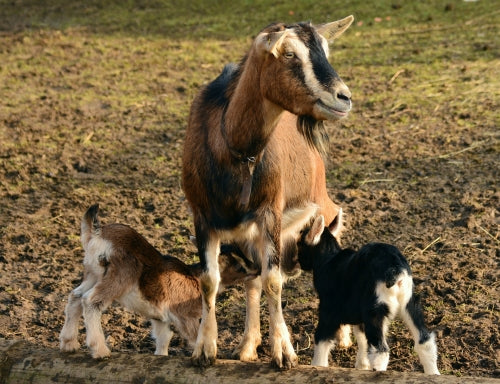14/12/2016
Dr. Colleen Lewis / December 14, 2016
Supernumerary, or extra teats in ruminants are defined as any teat that is in excess of the normal number of teats. Having five or six teats is not normal in a cow, but not uncommon. Which ones are extra? Usually, it is very obvious; sometimes it is helpful to look at the placement, size, and sphincter development of all of the teats to determine the necessary ones verses the extra ones. Most of the extra teats in cattle are blind, and do not have a streak canal or attachment to mammary tissue. A blind teat is not capable of producing milk. Blind teats are often found in pairs. It is not uncommon in cattle to find a pair of “button-like” projections on the rear quarters, or a couple of lesser developed dangly teats next to the good ones. Causing little more than an unsightly rear udder view, blind teats in a commercial beef or goat herd are not typically a problem.

Most extra teats are of no consequence, but in some instances, they can cause problems down the road. When an extra teat is closely associated with one of the necessary teats, it may interfere with milkability. To nurse efficiently, a calf will form a seal around the base of the teat. Two teats in close proximity may limit the ability of the calf to latch on properly. An extra teat closely associated with a necessary one can also prevent milking equipment from obtaining a proper seal. Supernumerary teats may also cause nipple confusion; occasionally, a newborn can get so focused on a bogus teat that he inadvertently ignores the real milk supply and ends up with hypoglycemia or failure of passive transfer (FPT).
The rare extra teat that is capable of producing a bit of milk is also the one that will potentially cause more harm than good. Not only can a newborn waste a lot of time on this teat without much progress, the teat can be oddly shaped and either not be completely milked out or not be milked at all. Residual milk can potentially lead to infection in the udder, mastitis. Goats will have the same extra teat issues as cattle. Yet, goats can also have some unusual extra teats that branch off the side of another teat, commonly called antler teats, fish-tail teats or spurs. They are interesting, but can cause problems with nursing and milking.

Extra teats are hereditary. Selection and culling will help to reduce the genetic potential for extra teats in your herd. It is difficult to eliminate the gene all together, as there are carriers that will not exhibit the condition, yet they can pass it to their offspring.
Consider teat removal if a supernummary teat can potentially cause difficulties with nursing, milking or exhibition. Check heifers and goat kids for extra teats at two to four months of age for early detection and removal. Stress and discomfort with teat removal increases with age. In cattle, processing is a convenient time to remove undesirable teats, as they are becoming developed enough to recognize as problematic. As heifers mature to adulthood, teat removal is only recommended in cases of severe injury. Goats have a very low pain tolerance for teat surgery. General anesthesia is important to consider, as local anesthesia is often painful in itself and inadequate.
When surgically removed, pain management is essential in both heifers and doelings. After-care is minimal, only requiring daily monitoring. Make sure that the surgery site stays clean and dry. Any problems with the site should be brought immediately to the attention of your veterinarian. If external sutures are placed, suture removal occurs in 7 to 10 days.
About the Author
Dr. Colleen Lewis is a 1996 graduate of Kansas State University, College of Veterinary Medicine. Her career has taken her to many places as a practice owner, consultant, embryologist, and mentor. She enjoys mixed animal practice, teaching, traveling, farming and high school sports with her husband, Andrew and their three boys.




